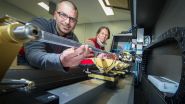(Press-News.org) Was it a massive migration? Or was it rather a slow and persistent seeping of people, items and ideas that laid the foundation for the demographic map of Europe and Central Asia that we see today? The Bronze Age (about 5,000 - 3,000 years ago) was a period with large cultural upheavals. But just how these upheavals came to be have remained shrouded in mystery.
Assistant Professor Morten Allentoft from the Centre for GeoGenetics at the Natural History Museum of Denmark at the University of Copenhagen is a geneticist and is first author on the paper in Nature. He says:
- Both archaeologists and linguists have had theories about how cultures and languages have spread in our part of the world. We geneticists have now collaborated with them to publish an explanation based on a record amount of DNA-analyses of skeletons from the Bronze Age.
So far the archaeologists have been divided into two different camps. Professor Kristian Kristiansen of the University of Gothenburg, who initiated the project together with Lundbeck Foundation Professor Eske Willerslev says:
- The driving force in our study was to understand the big economical and social changes that happened at the beginning of the third millennium BC, spanning the Urals to Scandinavia. The old Neolithic farming cultures were replaced by a completely new perception of family, property and personhood. I and other archaeologists share the opinion that these changes came about as a result of massive migrations.
With this new investigation the researchers confirm that the changes came about as a result of migrations. The researchers think that this is interesting also because later developments in the Bronze Age are a continuation of this new social perception. Things add up because the migrations can also explain the origin of the northern European language families. Both language and genetics have been with us all the way up to the present. Kristian Kristiansen even thinks that it was crucial events that happened during these few centuries, as crucial as the colonization of the Americas.
One of the main findings from the study is how these migrations resulted in huge changes to the European gene-pool, in particular conferring a large degree of admixture on the present populations. Genetically speaking, ancient Europeans from the time post these migrations are much more similar to modern Europeans than those prior the Bronze Age.
Mobile warrior people
The re-writing of the genetic map began in the early Bronze Age, about 5,000 years ago. From the steppes in the Caucasus, the Yamnaya Culture migrated principally westward into North- and Central Europe, and to a lesser degree, into western Siberia. Yamnaya was characterized by a new system of family and property. In northern Europe the Yamnaya mixed with the Stone Age people who inhabited this region and along the way established the Corded Ware Culture, which genetically speaking resembles present day Europeans living north of the Alps today.
Later, about 4,000 years ago the Sintashta Culture evolved in the Caucasus. This culture's sophisticated new weapons and chariots were rapidly expanding across Europe. The area east of the Urals and far into Central Asia was colonized around 3,800 years ago by the Andronovo Culture. The researchers' investigation shows that this culture had a European DNA-background.
During the last part of the Bronze Age, and at the beginning of the Iron Age, East Asian peoples arrived in Central Asia. Here it is not genetic admixture we see, but rather a replacement of genes. The European genes in the area disappear.
A new scale
These new results derive from DNA-analyses of skeletons excavated across large areas of Europe and Central Asia, thus enabling these crucial glimpses into the dynamics of the Bronze Age. In addition to the population movement insights, the data also held other surprises. For example, contrary to the research team's expectations, the data revealed that lactose tolerance rose to high frequency in Europeans, in comparison to prior belief that it evolved earlier in time (5,000 - 7,000 years ago). Co-author and Associate Professor Martin Sikora from the Centre for GeoGenetics says:
- Previously the common belief was that lactose tolerance developed in the Balkans or in the Middle East in connection with the introduction of farming during the Stone Age. But now we can see that even late in the Bronze Age the mutation that gives rise to the tolerance is rare in Europe. We think that it may have been introduced into Europe with the Yamnaya herders from Caukasus but that the selection that has made most Europeans lactose tolerant has happened at a much later time.
The paper in Nature not only gives us a new glimpse into the Bronze Age. It is also the first time an actual population evolutionary study back in time has been made to this extent. Geneticist and director of the Centre for GeoGenetics Eske Willerslev elaborates:
- Our study is the first real large-scale population genomic study ever undertaken on ancient individuals. We analysed genome sequence data from 101 past individuals. This is more than a doubling of the number of genomic sequenced individuals of pre-historic man generated to date. The study is without any comparison to anything previously made. The results show that the genetic composition and distribution of peoples in Europe and Asia today is a surprisingly late phenomenon - only a few thousand years old.
INFORMATION:
The paper Population Genomics of Bronze Age Eurasia is published in the journal Nature 11. June 2015.
Take home message 1: The Bronze Age is where the genetic formation of the modern European is formed
Take home message 2: Genetically speaking the peoples of Central Asia were, until a couple of thousand years ago, Europeans
Take home message 3: The ability to drink milk among European adults was developed far later than previously thought END
An international team of scientists has found a dramatic ice sheet collapse at the end of the ice age before last caused widespread climate changes and led to a peak in the sea level well above its present height.
The team found the events 135,000 years ago caused the planet to warm in a different way to the end of the most recent ice age about 20,000 to 10,000 years ago.
The findings will help scientists understand the processes that control Earth's dramatic climate changes, said the leader of the study, Dr Gianluca Marino of The Australian National University (ANU).
"We ...
Several neurodegenerative disorders are caused by aggregates of a single protein known as alpha-synuclein. In collaboration with CNRS and the University of Antwerp, KU Leuven neurobiologists have discovered that the shape of these aggregates - 'cylinders' or 'ribbons' - determines whether a patient develops Parkinson's disease or Multiple System Atrophy, respectively.
Typical of neurodegenerative disorders is the disrupted communication between brain cells together with a loss of cells in specific brain regions. For some brain diseases this phenomenon is linked to a ...
The discovery of how a group of bacteria rapidly adapts to changing growth conditions could have implications for future antibiotic development, according to research at the University of Oxford and the University of York.
Led by Professor Colin Kleanthous at Oxford and Dr Christoph Baumann at York, the research which also involved key collaborators Mark Sansom at Oxford and Jacob Piehler at the University of Osnabrück, is published in Nature.
Gram-negative bacteria are a major cause of disease, in part because they have a robust outer membrane that protects ...
A University of Manchester led trial of a new psoriasis drug has resulted in 40 percent of people showing a complete clearance of psoriatic plaques after 12 weeks of treatment and over 90 percent showing improvement.
The research tested 2,500 people with psoriasis. Half were given a new drug - ixekizumab - either once every two or four weeks. The other half were given a placebo or a widely used drug for psoriasis called etanercept.
The ixekizumab groups showed quick and extensive improvements in their condition, outperforming the groups on placebo or etanercept. Around ...
wo NASA satellites provided a look inside and outside of Tropical Cyclone Ashobaa. NASA and JAXA's GPM satellite observed rainfall rates and cloud heights identifying powerful thunderstorms within the cyclone, and NASA's Aqua satellite provided an overall look at Ashobaa's cloud extent.
The Global Precipitation Measurement (GPM) core observatory had an excellent view of Tropical Cyclone Ashobaa in the Arabian Sea over on June 8, 2015 at 2131 UTC (5:31 p.m. EDT). As expected, Tropical Cyclone Ashobaa was more powerful than when seen by GPM earlier in the day. GPM's Microwave ...
Genetically modified fish that overexpress growth hormone have been created for more than 25 years, but unlike many domesticated crops, transgenic fish have yet to enter commercial production. Because of the difficulty inherent in eradicating an established fish population, efforts are under way to model the threat posed by possible invasions.
In an article for an upcoming issue of BioScience, a team of government and academic researchers, led by Robert Devlin of Fisheries and Oceans Canada, examined the possible outcomes of an accidental release of transgenic fish. Their ...
The air around us is a chaotic superhighway of molecules whizzing through space and constantly colliding with each other at speeds of hundreds of miles per hour. Such erratic molecular behavior is normal at ambient temperatures.
But scientists have long suspected that if temperatures were to plunge to near absolute zero, molecules would come to a screeching halt, ceasing their individual chaotic motion and behaving as one collective body. This more orderly molecular behavior would begin to form very strange, exotic states of matter -- states that have never been observed ...
Most galaxies are clumped together in groups or clusters. A neighboring galaxy is never far away. But this galaxy, known as NGC 6503, has found itself in a lonely position, at the edge of a strangely empty patch of space called the Local Void.
The Local Void is a huge stretch of space that is at least 150 million light-years across. It seems completely empty of stars or galaxies. The galaxy's odd location on the edge of this never-land led stargazer Stephen James O'Meara to dub it the "Lost-In-Space galaxy" in his 2007 book, Hidden Treasures.
NGC 6503 is 18 million ...
New research from UBC and the Child & Family Research Institute at BC Children's Hospital shows that risky outdoor play is not only good for children's health but also encourages creativity, social skills and resilience.
The findings, published in the International Journal of Environmental Research and Public Health, found that children who participated in physical activity such as climbing and jumping, rough and tumble play and exploring alone, displayed greater physical and social health.
"We found that play environments where children could take risks promoted increased ...
Google searches for information on melanoma and skin cancer increased over the summer months during a five-year period, although the level of interest did not correlate with the melanoma mortality to incidence ratio, suggesting that increased search volumes may not be associated with early detection, according to a research letter published online by JAMA Dermatology.
Researcher Kyle T. Amber, M.D., of MacNeal Hospital, Berwyn, Ill., and coauthors used Google Trends, a research tool which quantifies interest in topics at the population level by analyzing all search queries ...





